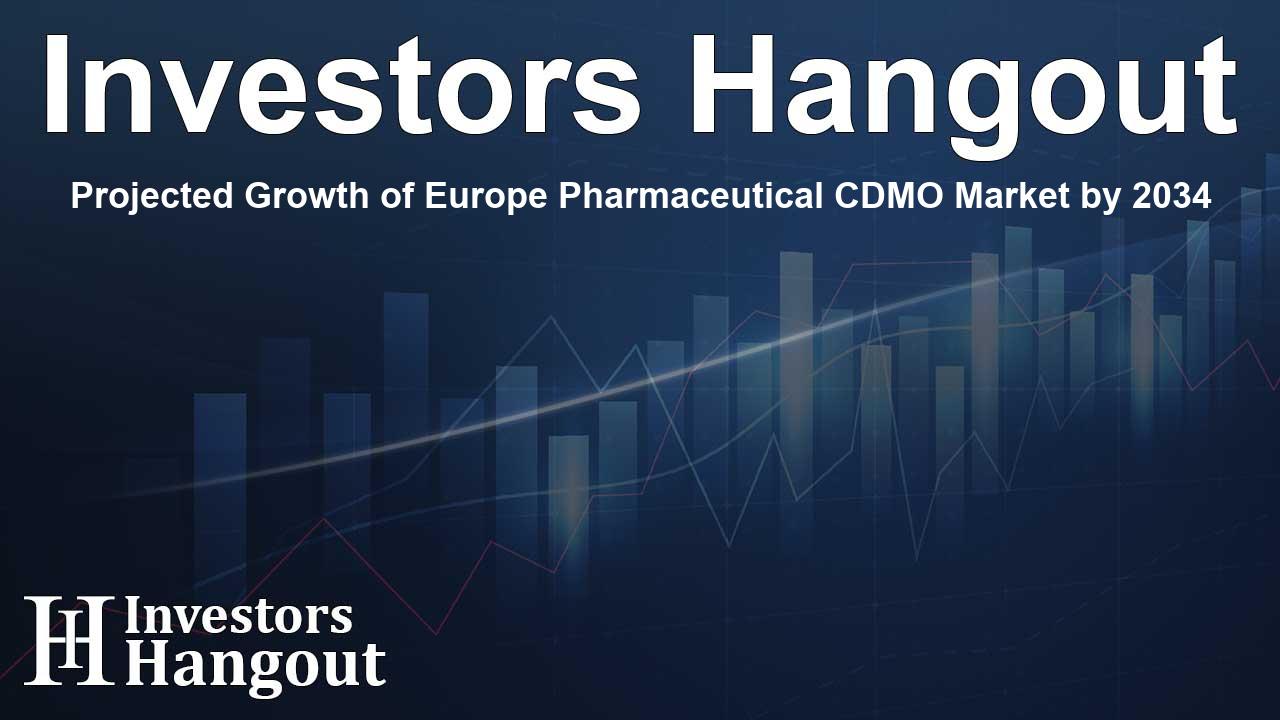Projected Growth of Europe Pharmaceutical CDMO Market by 2034

Exploring the Future of the Pharmaceutical CDMO Market in Europe
The pharmaceutical Contract Development and Manufacturing Organization (CDMO) market in Europe has shown remarkable growth in recent years, with expectations set to continue on an upward trajectory. Recent analysis indicates that the market, which was valued at approximately USD 35.48 billion in 2024, is anticipated to nearly double, reaching around USD 70.05 billion by 2034. This represents a compound annual growth rate (CAGR) of 7.04%, as revealed in a comprehensive study released by a well-known healthcare research firm.
Factors Driving Market Growth
Several key factors are fueling this growth in the pharmaceutical CDMO sector. One of the most notable is the increasing trend of companies outsourcing drug development and manufacturing processes. As pharmaceutical companies face escalating pressures to cut costs while simultaneously demanding complex biologics, they turn to CDMO partners to handle specialized tasks efficiently.
An Overview of Essential Market Dynamics
Within the CDMO landscape, notable growth drivers include:
- Rising Demand for Therapeutics: There is an increasing need for new therapeutics, particularly in oncology, due to the rising incidence of cancer. Consequently, pharmaceutical companies are investing in CDMO partnerships to expedite drug development.
- Regulatory Support and Local Production: The European regulatory framework promotes local production and adherence to quality standards, which are vital as companies reassess their supply chains in light of disruptions.
- Technological Advancements: The implementation of state-of-the-art technologies in continuous manufacturing and digitalization has helped CDMOs enhance their operational efficiencies.
- Cost Pressures: Faced with diminishing profit margins, many companies find outsourcing manufacturing to be a more economical option than maintaining in-house facilities.
Regional Insights: Germany and France
Germany currently dominates the European pharmaceutical CDMO market, boasting a robust infrastructure and significant investments in research and development (R&D). However, France is noteworthy for its rapid growth potential, expected to expand due to favorable policies and increased funding in the biotech sector.
Market Share and Segmentation Analysis
The market is segmented into various dimensions:
- Product Type: The Active Pharmaceutical Ingredient (API) segment leads in revenue. This is driven by pharmaceuticals outsourcing a considerable portion of their API activities to CDMOs.
- Application Areas: The oncology segment holds a dominant share due to the increasing demand for effective treatments.
- End-User Categories: Large pharmaceutical companies represent the largest customer segment, engaging in long-term contracts with CDMOs for consistent production needs.
Recent Developments Influencing the Market
In September 2025, AGC Pharma Chemicals announced an investment of €110 million aimed at enhancing its production facility in Spain to boost API manufacturing capacity by approximately 30%. Such investments are key as they reflect the industry's dedication to meeting increasing market demands and ensuring sustainable production capabilities.
Challenges Faced by the CDMO Sector
While the outlook is positive, challenges remain. One of the most pressing issues is the rising cost of labor and regulatory compliance, particularly as European CDMOs compete with lower-cost providers in Asia. Additionally, there is constant pressure regarding quality and environmental standards, which are critical for maintaining market position.
Conclusion: Embracing a Transformative Future
The European pharmaceutical CDMO market is on the brink of a transformative phase, driven by advancements in technology and a growing emphasis on outsourced production capabilities. As the landscape continues to evolve, companies that can adapt and innovate will thrive amidst the challenges. Contact us if you have any questions or need further insights into this dynamic market.
Frequently Asked Questions
What is the current market size of the European pharmaceutical CDMO sector?
The European pharmaceutical CDMO market was valued at approximately USD 35.48 billion in 2024.
What are the main factors driving growth in this market?
Main factors include the rise in demand for new therapeutics, regulatory support for local production, advancements in technology, and cost pressures on pharmaceutical companies.
Which country is leading the pharmaceutical CDMO market in Europe?
Germany currently holds the largest market share, attributed to its robust infrastructure and R&D investments.
What challenges are facing the pharmaceutical CDMO industry?
Challenges include rising labor costs, stringent regulatory compliance requirements, and competition from lower-cost providers in other regions.
How is the oncology segment affecting the CDMO market?
The oncology segment is significant due to increasing cancer incidence rates and the demand for innovative and effective treatments, impacting CDMO growth positively.
About The Author
Contact Owen Jenkins privately here. Or send an email with ATTN: Owen Jenkins as the subject to contact@investorshangout.com.
About Investors Hangout
Investors Hangout is a leading online stock forum for financial discussion and learning, offering a wide range of free tools and resources. It draws in traders of all levels, who exchange market knowledge, investigate trading tactics, and keep an eye on industry developments in real time. Featuring financial articles, stock message boards, quotes, charts, company profiles, and live news updates. Through cooperative learning and a wealth of informational resources, it helps users from novices creating their first portfolios to experts honing their techniques. Join Investors Hangout today: https://investorshangout.com/
The content of this article is based on factual, publicly available information and does not represent legal, financial, or investment advice. Investors Hangout does not offer financial advice, and the author is not a licensed financial advisor. Consult a qualified advisor before making any financial or investment decisions based on this article. This article should not be considered advice to purchase, sell, or hold any securities or other investments. If any of the material provided here is inaccurate, please contact us for corrections.
